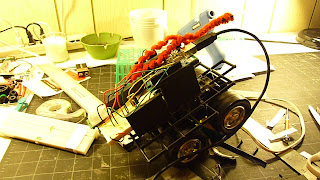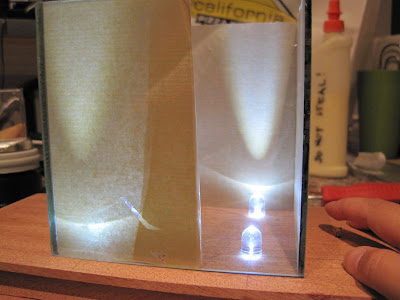 Made up of "Tectonic Plates" that interconnect... The skin itself reveals and the Earth bares the components (metal). The material chosen has translucency so when closed it still interacts as one walks by.
Made up of "Tectonic Plates" that interconnect... The skin itself reveals and the Earth bares the components (metal). The material chosen has translucency so when closed it still interacts as one walks by. Wednesday, June 30, 2010
The Skin Bares...
 Made up of "Tectonic Plates" that interconnect... The skin itself reveals and the Earth bares the components (metal). The material chosen has translucency so when closed it still interacts as one walks by.
Made up of "Tectonic Plates" that interconnect... The skin itself reveals and the Earth bares the components (metal). The material chosen has translucency so when closed it still interacts as one walks by. Tuesday, June 29, 2010
Core Vision Exploration...Netbook Style
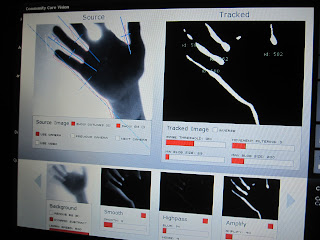 Well...within one hours of hearing about this core vision software its uploaded and running. Although I did not use an infrared camera I successfully used my webcam and tweaked the settings to get similar results. Currently I am working on how to export this interactivity of movement to LED's versus a screen...
Well...within one hours of hearing about this core vision software its uploaded and running. Although I did not use an infrared camera I successfully used my webcam and tweaked the settings to get similar results. Currently I am working on how to export this interactivity of movement to LED's versus a screen...Tuesday, June 22, 2010
SYSTEMS

The idea is to simplify the 2' x 2' area into layered systems. By layering systems group members can individually work on code and their own intervention...then they can be combined into a holistic idea.
SURFACE


THE MOVABLE SURFACE MUST BE TRANSPARENT OR TRANSLUCENT!!!
INTERACTIVE PIECE
 How to interact...or make the person activate it?
How to interact...or make the person activate it?Ideas for the next Project
Thursday, June 17, 2010
Posting Settings Design Monetize View Blog New Post Edit Posts Edit Pages


// Example 03A: Turn on LED when the button is pressed // and keep it on after it is released // // Copy and paste this example into an empty Arduino sketch #define LED 13 // the pin for the LED #define BUTTON 7 // the input pin where the // pushbutton is connected int val = 0; // val will be used to store the state // of the input pin int state = 0; // 0 = LED off while 1 = LED on void setup() { pinMode(LED, OUTPUT); // tell Arduino LED is an output pinMode(BUTTON, INPUT); // and BUTTON is an input } void loop() { val = digitalRead(BUTTON); // read input value and store it // check if the input is HIGH (button pressed) // and change the state if (val == HIGH) { state = 1 - state; } if (state == 1) { digitalWrite(LED, HIGH); // turn LED ON } else { digitalWrite(LED, LOW); } } Once again with this code my LED's are running 010101010101010 on and off constantly... I am only achieving half brightness.
My new Light Monster
 So after Tuesday's presentations I decided to recreate my light project, since the last one failed. I went to the Dollar store for inspiration and found a small monster truck toy. I took it apart...and so it began. I already had a PIR sensor so I thought it would be funny to make a critter that "ran" at you when you needed some light. I looked online for code that would make the PIR sensor behave the way I wanted. I found code that gave the PIR appropriate delays. Thanks
So after Tuesday's presentations I decided to recreate my light project, since the last one failed. I went to the Dollar store for inspiration and found a small monster truck toy. I took it apart...and so it began. I already had a PIR sensor so I thought it would be funny to make a critter that "ran" at you when you needed some light. I looked online for code that would make the PIR sensor behave the way I wanted. I found code that gave the PIR appropriate delays. Thanks Kristian Gohlke / krigoo (_) gmail (_) com / http://krx.at
* @date: 3. September 2006
So the original code looks like this
//VARS
//the time we give the sensor to calibrate (10-60 secs according to the datasheet)
int calibrationTime = 30;
//the time when the sensor outputs a low impulse
long unsigned int lowIn;
//the amount of milliseconds the sensor has to be low
//before we assume all motion has stopped
long unsigned int pause = 5000;
boolean lockLow = true;
boolean takeLowTime;
int pirPin = 3; //the digital pin connected to the PIR sensor's output
int ledPin = 13;
/////////////////////////////
//SETUP
void setup(){
Serial.begin(9600);
pinMode(pirPin, INPUT);
pinMode(ledPin, OUTPUT);
digitalWrite(pirPin, LOW);
//give the sensor some time to calibrate
Serial.print("calibrating sensor ");
for(int i = 0; i < locklow =" false;" takelowtime =" true;" lowin =" millis();" takelowtime =" false;"> pause){
//makes sure this block of code is only executed again after
//a new motion sequence has been detected
lockLow = true;
Serial.print("motion ended at "); //output
Serial.print((millis() - pause)/1000);
Serial.println(" sec");
delay(50);
}
}
New code is
int calibrationTime = 30;
//the time when the sensor outputs a low impulse
long unsigned int lowIn;
//the amount of milliseconds the sensor has to be low
//before we assume all motion has stopped
long unsigned int pause = 3000;
boolean lockLow = true;
boolean takeLowTime;
int pirPin = 3; //the digital pin connected to the PIR sensor's output
int motorPin = 13; //the digital pin connected to the motor's output
int ledPin = 8; //the digital pin connected to the led output
int led2Pin = 10; //the digital pin connected to the led output
/////////////////////////////
//SETUP
void setup(){
Serial.begin(9600);
pinMode(pirPin, INPUT);
pinMode(motorPin, OUTPUT);
pinMode(ledPin, OUTPUT);
pinMode(led2Pin, OUTPUT);
digitalWrite(pirPin, LOW);
//give the sensor some time to calibrate
Serial.print("calibrating sensor ");
for(int i = 0; i < locklow =" false;" takelowtime =" true;" lowin =" millis();" takelowtime =" false;"> pause){
//makes sure this block of code is only executed again after
//a new motion sequence has been detected
lockLow = true;
Serial.print("motion ended at "); //output
Serial.print((millis() - pause)/1000);
Serial.println(" sec");
delay(50);
}
}
}
}

And the final monster
Tuesday, June 15, 2010
I killed it!
so i got everything connected but I failed to understand the sensitivity of electronics and power 6VDC is not = 9VDC. Going to get new inverter and try again.
Arduino Lamp Project
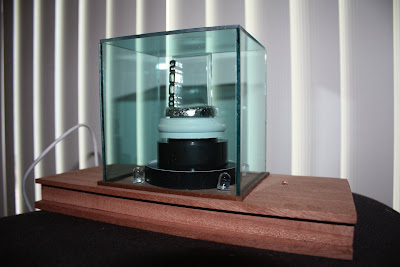

Objective:
original globe
Originally my plan is to make a wooden base for the globe to rest on and then somehow pierce 4 holes in to the globe so that it can house 4 Led lights.... so I used a piece of wood that i had from my design class and cut it to pieces to construct my base. Also I wanted to hide the breadboard and the Arduino underneath the wooden base for aesthetic.


My globe came rolling out of the bag and fell on the floor. My first thought is the buy a new globe, but then i thought that will defeat my objective of this project then i thought about finding another object to work with ...... So after a long deliberation on what to do next, i decided to redesign and create a transparent cover to house whats left of the globe, using Plexiglass......
Construction II:
Parts:
Shuttered Globe, Wood Plank, 2 Transistors, wires, breadboard, arduino, Photo resistors, 4 LED Lights, Plexy glass.
Installation Process:
Cut the base and marked the location of the 4 Led lights. In this project i have my Led lights on each corner of my new globe cover. Also marked the location of the photo resistor.
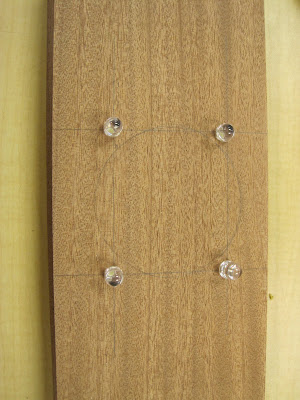 I soldered the led's endpoint with a longer wires so that i can reach the breadboard and arduinos' pins.then i installed the lights and the arduino on the top of the base.
I soldered the led's endpoint with a longer wires so that i can reach the breadboard and arduinos' pins.then i installed the lights and the arduino on the top of the base.



After all the wiring wirings and the LEDSs are working with Arduino, I constructed the the cover / housing.
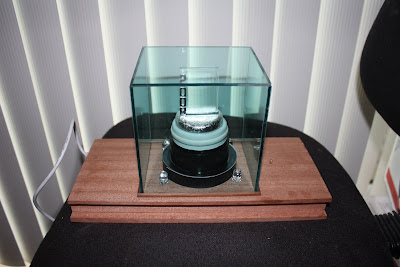
Code and Schematic: http://tinyurl.com/crdum6''
/*
* A simple programme that will change the intensity of
* an LED based * on the amount of light incident on
* the photo resistor.
*
*/
//PhotoResistor Pin
int lightPin = 0; //the analog pin the photoresistor is
//connected to
//the photoresistor is not calibrated to any units so
//this is simply a raw sensor value (relative light)
//LED Pin
int ledPin = 9; //the pin the LED is connected to
//we are controlling brightness so
//we use one of the PWM (pulse width
// modulation pins)
void setup()
{
pinMode(ledPin, OUTPUT); //sets the led pin to output
}
/*
* loop() - this function will start after setup
* finishes and then repeat
*/
void loop()
{
int lightLevel = analogRead(lightPin); //Read the
// lightlevel
lightLevel = map(lightLevel, 0, 900, 0, 255);
//adjust the value 0 to 900 to
//span 0 to 255
lightLevel = constrain(lightLevel, 0, 255);//make sure the
//value is betwween
//0 and 255
analogWrite(ledPin, lightLevel); //write the value
}
Sunday, June 13, 2010
combined both codes and added a little of my handy work :-)
/*Fireflies*/
int value;
int pwmPin = 11; // light connected to digital pin 11-- I just chose an initial value
//int ledpin2 = 9;
long time=0;
int period = 500;
int i = 0;
long blink_delay = 1000; // these must be declared as long due to the random() operation
long blink = 3;
long random_led = 55;
const byte pwmPins [] = {3, 5, 6, 9, 10, 11};
int lightpin = 0; //the ana log pin the
//photoresistor is
//connected to
//the photo resistor is not
//calibrated to any units so
//this is simply a raw sensor value (relative light)
//LED pin
int pwmpin= 11;//the pin the LED is conneced to
//we are conrtolling the brigtness so
//we use one of the PWM (pulse
//width modulation pins)
int pwmpin = 5
int pwmpin = 6
int pwmpin = 9
int pwmpin = 10
int pwmpin = 3
void setup()
{
pinMode(pwmpin, OUTPUT); //sets the led pin to
//output //nothing to setup
}
void loop()
{
int lightLevel = analogRead(lightpin); //Read the
// light level
lightLevel = map(lightLevel, 0, 900, 0, 255);
//adjust the value 0 to 900 to
lightLevel = constrain(lightLevel, 0, 255);
//make sure the value is between 0 and 255
analogWrite(ledpin, lightLevel); //Wright the value
}
{
int lightLevel = analogRead(lightpin); //Read the
// light level
lightLevel = map(lightLevel, 0, 900, 0, 255);
//adjust the value 0 to 900 to
lightLevel = constrain(lightLevel, 0, 255);
//make sure the value is between 0 and 255
analogWrite(ledpin, lightLevel); //Wright the value
}
{
choose_firefly();
fade();
blink_delay = random(500, 4001);
delay(blink_delay);
blink = random(2, 5);
}
void fade()
{
for(i=0; i<255;)
{
time = i;
value = abs(-127+127*cos(4*PI/period*i)); //the -127 value shifts the cosine curve negative with a zero initial value; abs shifts everything positive
analogWrite(pwmPin, value); // sets the value (range from 0 to 255)
delay(blink);
i++;
}
}
void choose_firefly()
{
pwmPin = pwmPins [random (0, 6)];
}
but apparentlly my work was "UNQUALIFIED"
error: expected unqualified-id before numeric constant In function 'void loop()': At global scope:
the mistake wasn't in organization but the Arduino is not recognizing or not accepting something in the code, to my understanding.
could use a little input........
otherwise I'm just stuck with a light show.
0101010101010101010101010
making an arduino nightlight continued

horizontally i hooked up multiple LEDs and the wires like the yellow one you see, those wires are hooked up to the digital PWM numbers (3, 5, 6, 9, 10, 11)
then i have 2 codes that i followed
First the Photo cell
/*
*A simple Programme that will change the
*intensity of an LED based on the amount of
* light incident on the photo resistor.
*
*/
//photoresistor pin
int lightpin = 0; //the ana log pin the
//photoresistor is
//connected to
//the photo resistor is not
//calibrated to any units so
//this is simply a raw sensor value (relative light)
//LED pin
int ledpin = 9;//the pin the LED is conneced to
//we are conrtolling the brigtness so
//we use one of the PWM (pulse
//width modulation pins)
void setup()
{
pinMode(ledpin, OUTPUT); //sets the led pin to
//output
}
/* loop() - this funtion will start after setup
*finishes and then repeat
*/
void loop()
{
int lightLevel = analogRead(lightpin); //Read the
// light level
lightLevel = map(lightLevel, 0, 900, 0, 255);
//adjust the value 0 to 900 to
lightLevel = constrain(lightLevel, 0, 255);
//make sure the value is between 0 and 255
analogWrite(ledpin, lightLevel); //Wright the value
}
Then i worked with the LED pattern code
/*This sketch is intended to approximate the blinking of fireflies. It varies the delay between
blinks and varies the total blink time. I've used the random() function to vary which PWM output
is chosen for the next blink.
Hope you get some enjoyment out of it. I created it as a fun night light for my kids.
Chad Richardson -- Chad@ChadsCustomWood.net
*/
int value;
int pwmPin = 11; // light connected to digital pin 11-- I just chose an initial value
//int ledpin2 = 9;
long time=0;
int period = 500;
int i = 0;
long blink_delay = 1000; // these must be declared as long due to the random() operation
long blink = 3;
long random_led = 55;
const byte pwmPins [] = {3, 5, 6, 9, 10, 11};
void setup()
{ //nothing to setup
}
void loop()
{
choose_firefly();
fade();
blink_delay = random(500, 4001);
delay(blink_delay);
blink = random(2, 5);
}
void fade()
{
for(i=0; i<255;)
{
time = i;
value = abs(-127+127*cos(4*PI/period*i)); //the -127 value shifts the cosine curve negative with a zero initial value; abs shifts everything positive
analogWrite(pwmPin, value); // sets the value (range from 0 to 255)
delay(blink);
i++;
}
}
void choose_firefly()
{
pwmPin = pwmPins [random (0, 6)];
}
making an arduino nightlight
first the photo cell



Saturday, June 12, 2010
http://diyroboticslab.wordpress.com/2009/06/05/correcting-arduino-compiler-errors/
playing with arduino servo motors and potentiometers


here is how i hooked up the servo with the potentiometer on the arduino

My first arduino attempt

with my first Arduino attempt, i messed around with button and a LED, its suppose to control the button LED functions with the simple press of the button that is stated from the reading "Getting Started with Arduino." After that, i uploaded a sketch example from the arduino program to make the led blink or stay on by command; by reading that, the sketch stated how to manipulate the LED function by changing its digital write (the actions of the LED) from the when it turns on and off as it blinks. by changing its actions, i messed around with its Delay numbers later learning that the LED's blink at a thousandth of a second.
//example of what i was messing with to command the LEDS with in the script thats written in RED
/*
Blink
Turns on an LED on for one second, then off for one second, repeatedly.
The circuit:
* LED connected from digital pin 13 to ground.
* Note: On most Arduino boards, there is already an LED on the board
connected to pin 13, so you don't need any extra components for this example.
Created 1 June 2005
By David Cuartielles
http://arduino.cc/en/Tutorial/Blink
based on an orginal by H. Barragan for the Wiring i/o board
*/
int ledPin = 13; // LED connected to digital pin 13
// The setup() method runs once, when the sketch starts
void setup() {
// initialize the digital pin as an output:
pinMode(ledPin, OUTPUT);
}
// the loop() method runs over and over again,
// as long as the Arduino has power
void loop()
{
digitalWrite(ledPin, HIGH); // set the LED on
delay(1000); // wait for a second
digitalWrite(ledPin, LOW); // set the LED off
delay(1000); // wait for a second
}
the lower the number the faster the LEDs respond in turning on and off. the higher the longer is takes it to respond.







